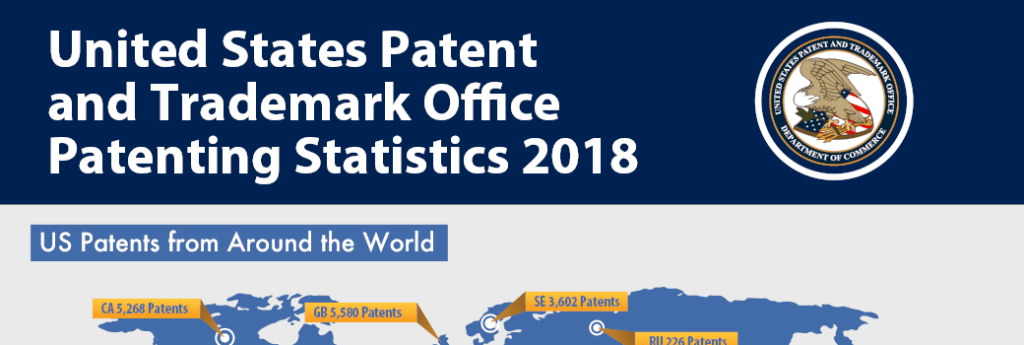By Matt Troyer, Director of Patent Analytics at Anaqua
As we prepare our 2018 year in review of the USPTO patent and publication statistics, we see a year where patent quality and utility to the patent owner is more important than ever. This results in little movement in the overall numbers, but what we believe is likely to be an overall increase in patent quality. We are seeing the emergence of new technologies, such as autonomous vehicles, and we had the USPTO release its 10 millionth patent. So, as we look at USPTO patent statistics for 2018 as analyzed in Anaqua’s AcclaimIP, while there were few significant changes in the numbers, other factors come into play.
In 2018, there were 341,102 granted patents, which was actually a drop of 3.3 percent from 2017. This continues a five-year trend where grants have been essentially flat. Further, there were 376,610 US applications published in 2018, which is only 1,900 more than 2017, barely a ½ percent change.
And it’s not just the past year that has seen minimal change – looking back over the past five years, the number of published applications has not fluctuated significantly. The gap between number of applications and number of grants has narrowed, meaning less growth in the backlog. If the number of grants staying consistent becomes a trend, the USPTO could accept the current average pendency from filing to grant, or they could add resources to reduce the backlog; in either case, they have some stability without the pressure of more applications than they can handle.
Patent owners have new portfolio management tools and analytics, allowing them to do a better job of filing patent applications that are more useful. Aligning IP with the business ensures that patent portfolios do their job of protecting their products and roadmap, providing defensive use, and making money via licensing, sales, and enforcement. Constrained budgets mean that IP executives need to be more focused on their portfolio strategies, and the statistics imply that filers are being a bit more selective in what to protect.
When you look at who is getting patents, the top grantees continue to drive the market. The top 25 patentees this year received over 62,000 patents or more than 18% of all patents granted by the USPTO, the same as 2017. And for the second year in a row, IBM led the field with over 9,000 patents granted. And for the second year in a row, they are the only patentee to crack the 9,000-patent barrier, cementing their status as one of the most innovative businesses in the world.
While technology continues to be the leading patent class, transportation has jumped to second. Self-driving vehicles and related capabilities have had a big impact on innovation. In fact, Ford cracked the top 10, joining perennial technology leaders IBM, Samsung, Intel, Apple, and others.
When looking at patents from around the world, of the top 10 countries of origin filing at the USPTO, only China saw any significant increase, with growth of more than 15% in the number of patents granted. In fact, most of the top 10 countries saw decreases larger than the average 3.3% decrease seen for all grants.
As we’ve now seen, the flattening of both patents and applications has reached five years, portending a trend we expect to continue. With the ability to integrate “big data” market analytics with internal portfolio analysis, IP organizations can be smarter about their patent strategies, better supporting the business while maintaining increased budget control. Business alignment will lead to not only more focused patenting strategies, but also more effective plans for pruning, licensing, and competitive actions.
The Top 8 Things That Stood Out in 2018:
- 427 Unique Filings – Number of applications filed in family of US9888252B2 from Toshiba Corp. Filed back in 2002, 124 Grants are still active in this very large family relating to video encoding technology.
- 3845 Citations – Three patents were granted in 2018 from a large family jointly owned by JST, Canon and Tokyo Inst of Tech covering semiconductor technology was cited by over 100 patent owners, but over 3032 of the citations come from Semiconductor Energy Labʼs applications.
- 33.5 Years of Pendency – Granted on Oct 30, 2018, patent US10113983B1 from Thermo Fisher Scientific relating to detection of explosives was filed back in 1985 when the median price of a home in the US was $75K and the price of a rib eye steak was $3.89/lb.
- 74 Rejection Events – Patent US10111224B2 from Interdigital Technologies covering reduced wireless bandwidth technology, has been referenced 74 times in rejection arguments including 26 102 rejection events. With a pendency of over six years, the associated application had a long time to be referenced prior to grant!
- 244 Claims – Patent US10051905B2 from Levi Strauss & Co. covering laser finishing of apparel is the most thoroughly claimed invention of 2018. Three additional US continuations have been filed (and published) in this family all of which are currently pending.
- 1,096,868 Words – Number of words in patent US9859923B2 from Sun Patent Trust. Ironically, this high-density patent covers a low-density parity checking technology.
- 60 Inventors – Number of inventors who cooperated on patent US9971713B2 from GlobalFoundries. Hailing mostly from Yorktown Heights, NY and Rochester, MN, this team manage to span the 1200 mile distance between them to pull of the most collaborative patent of the year.
- 302 Examiner Citations – Patent US10070751B2 from Nestec, SA survived a gauntlet of 302 cited patents by USPTO examiner Eric Stapleton. The claims were amended after the initial office action—approximately doubling in length prior to grant on Sept, 11 2018.
